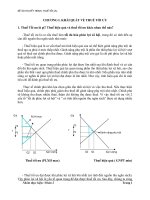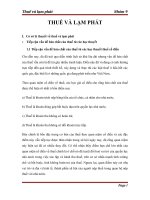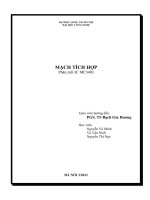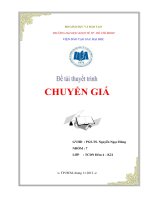TIỂU LUẬN MÔN PHÂN TÍCH BCTC PHÂN TÍCH CÔNG TY LIXCO
Bạn đang xem bản rút gọn của tài liệu. Xem và tải ngay bản đầy đủ của tài liệu tại đây (146.6 KB, 14 trang )
TIỂU LUẬN MÔN PHÂN
TÍCH BÁO CÁO TÀI CHÍNH
– PHÂN TÍCH CÔNG TY BỘT
GIẶT LIXCO
I.
Contents
I. Introduce about Lixco:................................................................................................1
II. Business Strategy Analysis..........................................................................................1
1. Industry Analysis: Apply a five force model to analyze the company......................1
a) Rivalry among existing competitors.....................................................................1
b) The threat of New Entrants:..................................................................................2
c) Theat of Substitute Products:................................................................................2
d) Buyers’ Power:......................................................................................................2
e) Suppliers’ Power:..................................................................................................3
2. Competitive Strategy Analysis:................................................................................3
a) Differentiation strategy:........................................................................................3
b) Cost leadership strategy:.......................................................................................3
3. Corporate Strategy Analysis.....................................................................................4
III. Accounting Analysis Steps.......................................................................................4
1. Step 1: Identifying Key Accounting Policies............................................................4
2. Step 2: Assessment of Accounting Flexibility..........................................................5
3. Step 3: Evaluate accounting strategy........................................................................6
4. Step 4: Evaluate the quality of disclosure of LIX’s company...................................6
5. Step 5: Identify Potential Red Flags.........................................................................7
6. Step 6: Undo Accounting Distortions.......................................................................7
IV. Financial Analysis....................................................................................................7
1. Analysis of Return and Profitability.........................................................................7
a) Analysis of Return:...............................................................................................7
b) Analysis of Profitability:.......................................................................................8
c) Analysis of Efficiency..........................................................................................8
d) Analysis of Working Capital.................................................................................8
e) Analysis of Leverage............................................................................................9
2. Analysis of credit risk:.............................................................................................9
a) Analyze liquidity ratios:........................................................................................9
b) Analyze solvency ratios......................................................................................10
V. Conclude...................................................................................................................10
[Type here]
ANALYSIS OF LIXCO DETERGENT JOINT STOCK COMPANY
(LIXCO)
II.
Introduce about Lixco:
Lixco, formerly known as Huan Huan Chemical Technology Company, was
established in 1972. After nearly 40 years of establishment and development, Lixco has
built itself a foothold. Sure on the domestic market as well as internationally. Lixco is
proud of being one of the leading Vietnamese companies specializing in producing and
trading all kinds of detergents such as detergent, dishwashing liquid.
Currently, the prestige of the Lix brand of detergent for domestic and foreign
customers has been confirmed through many titles that the Company has achieved over
the years: the title "Vietnam High Quality Goods" since 2006. By 2009, the title of
"Famous Brand" in 2006 and 2008, the title of "Prestigious Exporter" in 2004 and 2005,
the title of "Top 100 Trademarks 2009 "And several other prestigious awards.
These results are due to, the staff of employees in the company, they has constantly
been learning, creative, shut off in all its production and business activities. The company
has always set clear goals for its development, focusing on key areas of activity.
Vision: Become a leading company in manufacturing and trading household detergent
in Vietnam by sustainable development strategy, based on building strong distribution
system. Sure, pioneering investment in technology innovation to bring the highest added
value to shareholders, employees, and society.
Mission: Provide high quality LIX brand products at reasonable prices to consumers.
Sincerely and responsibly to the lives of people and society.
III. Business Strategy Analysis
1.
a)
Industry Analysis: Apply a five force model to analyze the company
Rivalry among existing competitors
The Vietnamese detergent market has been a big playground for Unilever and P & G
for a long time (88% market share). In recent years, the market has become more active
because of the appearance of some domestic brands, which makes LIX compete not only
with the two giants but also with other brands in the country such as Aba, Net, Vi Dan. It
is difficult for LIX to compete for face-to-face with Unilever and P&G products for a
variety of reasons, such as user tastes or advertising budgets, so LIX is focused on the
low price segment. Although the product is not so varied, there are still price differences
with foreign brands, the high cost of conversion helps LIX retain a certain number of
Trang 1/10
[Type here]
customers. However, for domestic competitors, the similarity of products, as well as not
much difference in price, again creates more competitive pressure for LIX. Moreover,
based on “economies of scale”, enterprises increase production expansion, the
competition is, therefore, more severe. Specialized production machinery leads to high
drainage costs which contribute to more competitive pressure. However, the market in
recent years has been growing steadily, this makes the competition a little bit more
comfortable, because if the poor growth will make the race even more fierce.
b)
The threat of New Entrants:
Unilever has the highest market share with Omo, Viso, Surf brands (more than half of
the nation's brands), P&G's Tide, and local brands. Other locations in the popular price
segment such as Lix, Dan, Net ...
Unilever and P&G can be said to be two "bosses" in the industry with a variety of
products, price segment from popular to high-end. With large distribution channels and
aggressive advertising strategies, a new company is hardly able to gain a small market
share in this industry. So the advantage for the new company entering the industry is
quite low.
c)
Theat of Substitute Products:
Currently, there is a product called "CLEAN BALL" that can replace detergent for
clothes.This is a smart product and has the effect of protecting the environment.
However, CLEAN BALL uses chemical and physiological responses, so the washing
environment is slower. Therefore, when washing laundry with a washing machine, it is
necessary to soak in water for a certain period of time. This type of ball is designed in
accordance with European standards should be tested with a stable source of water,
standard, "also in Vietnam uses too many different sources of water such as well water,
alum, salt ... Partial effect because of the need to "treat" the problem of water and
clothing at the same time. Therefore, for the Vietnamese market, this product can not
replace the washing powder. Therefore, for the powder market, the replacement factor is
quite low.
d)
Buyers’ Power:
Detergent is a price sensitive product because the products are similar and consumers
are easy to change. So the power of the buyer is strong. However, the number of
customers is large (most households use laundry detergents), the volume per buyer is
small and the lack of substitute products, the buyer's power weakens.
Trang 2/10
[Type here]
e)
Suppliers’ Power:
LIX is currently promoting its own branded product strategy. To produce their own
products, LIX needs to buy materials from suppliers. LIX's suppliers are mainly chemical
companies, the largest is Vinachem (according to The 2016 Financial Statement). There
are also many other providers. As a major supplier, Vinachem also has significant
influence. Overall, the power of the vendor is relatively average, but not too pressurized
for LIX.
2.
Competitive Strategy Analysis:
LIX company employs a combination of both strategies: Cost leadership and
Differentiation, but mainly focuses on Differentiation strategies
a)
Differentiation strategy:
In order to meet the increasing demands of the market, Lixico continues to focus on
developing new product lines in addition to ensuring product quality, continuously
improving its packaging to make a difference such as detergent Concentrated,
concentrated washing water, fabric softener using the technology of floating seeds. There
are also two new personal care products, Hand Wash and Shower Gel.
Unlike the two brands Omo and Tide, LIX's detergent and detergent have a specially
formulated formula with a mild aroma that retains their clothing longer. Biological
enzymes make it easy to fly stubborn stains without affecting the health of the user.
Especially, LIX thick detergent, easily dissolved in water and twice as strong detergent
than conventional detergent.
The packaging with simple design, not sophisticated, the color harmonious
combination of LIX products has made a difference in the brand than the competition and
also create a sympathy for consumers immediately.
b)
Cost leadership strategy:
The target market that Lixico is targeting is mostly housewives and students. The
characteristics of these objects are difficult or bargain prefer new cheap products.
Because the customer is not diversified, it has been causing tremendous pressure for the
company. So Lix is constantly trying to innovate technology, increase the scale, ... to cut
costs to still make a profit when the market for the products are popular but always
guaranteed credit and quality of LIX, meet the needs of the market segment that LIX
towards.
Trang 3/10
[Type here]
3.
Corporate Strategy Analysis
In the 90s last century, Lix was a much-hyped name in the detergent market.
However, the situation began to change in 1995, when Unilever and P & G
simultaneously entered into Vietnam. Since 2000, Lix has started processing for Unilever,
which has been the main partner of the company up to now. The processing for Unilever
helps LIX survive rather than bankrupt like other small companies. However, the fact that
the value of profit from this operation is not high and if company continue to process
without focus to build its own brand, no one can remember its brand in some day.
To solve this problem, LIX decided to reduce machining activities and increase
production. In general, LIX's manufacturing activity is still focused on the market for
detergents, doesn’t turning into other industries. However, the company has also made
great efforts to diversify its products, avoiding dependence on a certain item.
In terms of product diversification, Lix focuses on the development of liquid detergent
production, as it is a popular product in the developed countries. In pursuit of that goal,
Lix established Lix Binh Duong Branch in 2008 and began construction of a liquid
detergent factory. In addition, liquid detergent is produced in factories in Hanoi and Ho
Chi Minh City and Bac Ninh.
Besides, LIX has begun to enter the market of skin care products. This is expected to
be a product with high profit margins.
Through the above analysis, it can be seen that the company is using a concentric
diversification strategy, ie diversifying more products with the same technology. Thanks
to its economies of scale, the company minimizes production costs and profits from new
products. This can be considered the right direction of Lix in recent years.
IV. Accounting Analysis Steps
1.
Step 1: Identifying Key Accounting Policies
As a business enterprise in the field of consumer goods, key success factors of LIX
focus on the following points:
-
Managing costs and resources for the lowest cost of product
-
Revenue from sales and services
-
Ability to recover money from customers
From the key success factors mentioned above, we focus on some accounting policies
of the company as follows:
Trang 4/10
[Type here]
Inventory:
-
Inventories are recorded at the lower of historical cost and net realizable
value.
-
At LIX, there are the following inventory items: Raw materials, Work in
process, Finished goods
-
Inventory is accounted for using the weighted average method and applying
the regular enumeration method
-
Provision for devaluation of inventories is made for each item and
recognized in cost of goods sold
Method of recording revenue:
-
Revenue at LIX consists of 2 items: Revenue from sales and from services.
-
Revenues were recognized only if the following conditions are met:
The company has transferred to the buyer the significant risks and rewards of
ownership. The enterprise no longer having ability to control the goods The
amount of revenue can be measured reliably
The business has or will gain economic benefits from the transaction
Identify the part of work completed on the balance sheet’s date
Determine the costs associated with the sale; Costs incurred for transactions
and costs to complete service delivery transactions.
Accounts receivables:
2.
-
The Company recognizes receivables from customers as commercial
receivables arising from its purchase and sale transactions with independent
units.
-
The Company makes provision for doubtful receivables in accordance with
Tax’s policies and recognized in the enterprise management expenses.
Step 2: Assessment of Accounting Flexibility
We can assess the company's accounting flexibility in some key points:
-
Account receivables: As can be seen that the company apply the ratio of bad debt
provisions in accordance with the tax law. This can reduce the accounting’s work
but sometimes the regulations are not really suited to the situation of the company
This leads to less flexibility when LIX reporting receivables.
Trang 5/10
[Type here]
-
3.
Revenue: LIX complies with conditions for recording revenue in accordance with
the law. For contracts specifying that customers have the right to return a product or
service, revenue will not be recognized once the return is no longer available
This policy can avoid over-recording of revenue.
Step 3: Evaluate accounting strategy
Accounting convention: All the Financial Statements are prepared in accordance with
the accrual basis (except for the information related to cash flows)
Tangible fixed assets: Tangible fixed assets are depreciated in accordance with the
straight-line method over their estimated useful lives.
Intangible fixed assets: The Company's intangible fixed asset includes land use right
only. The land use right is amortized according to the straight- line method for the period
of 50 years.
Historical cost convention: Inventories Inventories are recognized at the lower of cost
or net realizable value.
4.
Step 4: Evaluate the quality of disclosure of LIX’s company
Quality of disclosure of a company are considered one of the most important
fundamentals for good corporate governance (Healy and Palepu, 2001).
In general, LIX’s the quality of disclosure is evaluated relatively effectively. In recent
years, LIX has provided adequate disclosure, explained about key accounting policies
and assumtions . As an example, In the company's 2014 work plan, one of the goals is
"To ensure fair and reasonable disclosure of the Company's financial and operating
information".
However, there is an issue to note that in 2016, the company LIX has suffered
Hochiminh Stock Exchange (HOSE) reminded to delay information disclosure and
delayed sending report to Stock Exchange.
LIX explained that the late disclosure was due to the fact that during this time the
company was concentrating on conducting business expansion procedures (branch
expansion in Bac Ninh), there were errors in disclosure information.
The adoption of Circular 52 of the Financial Ministry during the early time of the
company is not clear, so there are shortcomings, the company is committed to disclose
information in accordance with regulations.
Trang 6/10
[Type here]
5.
Step 5: Identify Potential Red Flags
Sales increased by about 11.2 % while accounts receivable increased about 22.1%,
nearly doubled. This could be due to the firm is relaxing its credit policies or artificially
loading up its distribution channels to record revenue as “channel stuffing”. It can also be
seen that, there is an increasing gap between a firm’s reported income before tax and its
cash flow from operating activity (78,414,115,413VND, by 2015 is 9,590,417,869VND).
When the firm’s accounting policies remain the same, there is usually a steady
relationship between earning and operating cash flow. Therefore, this change might
indicate subtle changes in the firm’s accrual estimates. During the period, the firm sold
some assets. Maybe because the firm wants to narrow down the business operations. But
clearly, the number of assets which the firm purchased is more than the liquidated assets.
Assumptions about downsizing are not appropriate. For business operations, the firm has
quite a lot of related-party transactions. These transactions may lack the objectivity of the
marketplace, but because related-party are the parent company and the subsidiaries within
the same corporation, so the management is quite difficult to fully control these
transactions.
6.
Step 6: Undo Accounting Distortions
After a careful review of LIX’s financial statements and accounting policies, along
with an analytical dissection of the sales and core expense manipulation diagnostics, we
feel the available information has no accounting distortions that must be corrected. LIX
did have a few accounting policies by which it could be flexible in its reports, but none of
these were used to exaggerate or understate any part of the financial statements
V.
Financial Analysis
1.
Analysis of Return and Profitability
a)
Analysis of Return:
ROE
50.00%
40.00%
30.00%
21.20%
20.00%
10.00%
0.00%
2013
40.06%
34.87%
ROE
22.08%
2014
2015
2016
2015 Net income increased
124% (due to an extraordinary profit of VND 53 billion from Vingroup to relocate the
mansion from Ha Noi to Bac Ninh) making its ROE increase from 22.08% to 40.06%.
Trang 7/10
[Type here]
b)
Analysis of Profitability:
25.00%
20.02%
17.86%
20.00%
15.00%
21.20%
20.69%
10.32%
10.00%
4.74%
4.61%
5.00%
0.00%
NET
8.05%
MARGIN
2013
2014
2015
2016
Sales and gross profit tend
to increase steadily over the years, ROE changes over the years mainly due to the change
of Net Margin. LIX's leverage remained steady over the years. In 2015, ROE reached the
highest level of 40.06% when Net Margin reached 10.32%.
From Analysis of Return and Profitability, it can be seen that the growth of the
company is quite stable, the new plant in Bac Ninh has been used to help reduce longterm transportation costs, increase profitability and competitiveness. Pictures of products
in the North market.
In 2017 LIX set net sales target of 2 billion, 2.4% over the same period. With the
current situation LIX can achieve the goal set out.
18
16.61
16
14
12
10
9.78
7.86
8
6
4
4.36
9.24
8.55
4.44
9.35
7.77
4.25
6.96
4.91
Asset tornover
Fixed asset turnover
Working capital
turnover
2
0
c)
2013
2014
2015
2016
Analysis of Efficiency
The x-turnover formula has the formula “sale / x”. From 2013 to 2016, revenue will
increase sharply in periods of 2013-2014 and 2015-2016. The period 2014-2015 has
increased but not as much as the other years.
Starting with asset turnover: The ratio of change is from 2013-2015 but suddenly
increased in 2016. It is easy to see that 2016 the total assets of the company decreased
compared to previous years but creat a large amount of revenue. The surge in 2016 is
normal.
Trang 8/10
[Type here]
The second fixed asset turnover fell sharply in 2016. The reason is that in 2016 the
company joined the Asian Economic Community and expanded its business to increase
its competitiveness. Working capital turnover also follows the trend of asset turnover.
d)
Analysis of Working Capital
2013
9,98
36,07
11,43
31,50
Inventory turnover
Days of inventory on hand
Receivables turnover
Days of sales outstanding
2014
11,35
31,73
15,67
22,97
2015
9,44
38,12
17,21
20,92
2016
11,11
32,40
18,07
19,92
The company's turnover turnover is generally downward volatility. It is easy to see the
bottom and peak of the trend line are lower than the bottom and the peak of the previous
period. This indicates that the company is showing signs of inefficient use of its
inventory. The good news is that the company's cash collection policy is progressing well
as receivables turnover is rising from 2013 to 2016. But the company should also pay
attention not to tighten too will reduce sales.
e)
Analysis of Leverage
LEVERAGE
2.0
1.5
1.0
0.5
-
1.64
1.68
1.75
Total debt/
Total assets
Total assets/
Equity
0.39
2013
0.41
2014
0.43
2015
0.42
1.73
2016
The leverage ratio up to
2015 indicates that the firm increased funding its asset by debt, then slightly down in
2016, and lower than the average of all listed SOEs. The firm still uses equity to finance
business operations, so the leverage is still appropriate and safe. Higher investment levels
by shareholders shows potential shareholders that the company is worth investing in since
so many investors are willing to finance the company. A higher ratio also shows potential
creditors that the company is more sustainable and less risky to lend future loans.
Key analysis question: Debt Policies
The company does not have too much debt, most of its assets are financed by equity
so financial risk is not high. The company uses its liabilities to invest in working capital
and mainly short-term liabilities. Non-current assets are probably financed by equity.
The company does not use the borrowings to pay dividends. Business activities in
recent years are profitable and dividends are divided from retained earnings.
Trang 9/10
[Type here]
2.
Analysis of credit risk:
a)
Analyze liquidity ratios:
Liquidity Ratios
200%
150%
173%
164%
100%
44%
50%
0%
155%
116%
114%
2013 0%
57%
37%
2014
112%
81%
40%
2015
127%
85% 74%
43%
2016
Current
Ratio
Quick
Ratio
112% Cash
79%
Ratio
57%
CF to
32%
Current
Liabilities
Industry - 2016
LIXCO's liquidity ratios have fallen sharply over the years, fluctuating with industry
trends. However, the company's ratio remains within safe range and ensures that the
company can control liquidity in the short term.
Debt Ratios
b)
0.8
0.7
0.6
0.52
0.5
0.39
0.4
0.3
0.2
0.1
0
2013
0.67
0.67
0.69
0.40
0.43
0.42
0.42
2014
2015
2016 Industry - 2016
0.58
Debt to
Equity
Debt to
Assets
Analyze solvency ratios
In recent years, debt ratios of LIXCO increased and fluctuated evenly with the
industry average. However, it is still relatively low, compared with other state enterprise s
and others industry. The main source of LIXCO’s financing is equity, so the company's
financial structure is less exposed to credit risk.
Solvency Ratio
200
174.26
Interest
coverage
150
100
72.08
75.92
45.21
50
0
2013
2014
2015
2016
Considering long-term debts of the
company, it can be seen that the debts of LIXCO mainly come from accounts payable to
suppliers, debts remains in low level. Specifically, in 2016, the long-term debt to equity
Trang 10/10
[Type here]
ratio is 0.06. This helps the company not to suffer the pressure on interest and debt
repayment.
From the analysis of liquidity ratios and solvency ratios, it can be seen that the
company has not really focused on the benefits of financial leverage. The business of
LIXCO is profitable, but the company can completely increase the level of debt financing
to develop the business and gain more proffit.
VI. Conclude
Over 40 years of development, LIXCO has overcome difficulties and gradually
become one of the companies that provide the largest detergent in Vietnam. LIXCO is
becoming stronger through a series of strategic moves that match the capabilities and
circumstances to conquer new revenue milestones.
Trang 11/10
[Type here]
REFERENCE
www.lixco.com
finance.vietstock.vn/LIX-ctcp-bot-giat-lix.htm
cafef.vn/lixco.html
/> /> />
/> />
Trang 12/10









